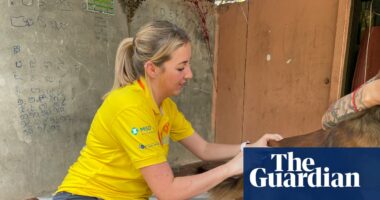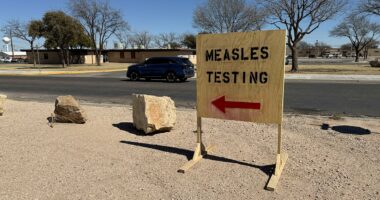Share this @internewscast.com
The first tray of yellow-lidded specimen jars holds chunks of flesh – lung, perhaps, or muscle – some cerebrospinal fluid and another liquid, possibly from a brain abscess. The second holds a rainbow of colourful fungi, cultivated from those specimens.
One growth is green and fluffy, like something you’d find in a sharehouse fridge – penicillium, maybe. Another is a dark grey or brown, like animal fur. There are bright white fuzzballs and blackish blobs. One growth leaches red into the medium it sits in.
Fungal pathogens come from all over Australia to this Adelaide laboratory, the National Mycological Reference Centre, for identification. Mycologists are on the lookout for new pathogens, which are starting to spread more because of climate change, and which can be deadly in the absence of effective antifungal drugs.
They work under biohazard signs, sorting specimens and growing colonies on petri dishes, to slice off and put under the microscope. There’s a weird, wonderful library of mycology books, a DNA sequencer and a reference collection with boxes and boxes full of vials, from azole-resistant Aspergillus to Zygomycetes.
Dr Sarah Kidd is the centre’s head. She was interested in Cryptococcus gattii, which live in eucalyptus trees and infect koalas, before she moved to Canada in 2006. And, serendipitously, there was a C gatti outbreak in Vancouver while she was there. It was a mystery how that fungus associated with Australia cropped up over there, but the theories are that it was something to do with changing global temperatures, perhaps some mutations.
Asked if those mutations scare her, Kidd says it’s “certainly not a good thing … but it keeps things interesting”.
The fascination with fungal pathogens has recently been piqued by the Netflix series The Last of Us, which stars Pedro Pascal, Bella Ramsey and a host of humans turned into zombies by a parasitic fungal infection.
“The fungus in The Last of Us, Cordyceps, it certainly does cause infection and sort of zombifies, if you will, insects,” Kidd says.
“But insects have a much cooler body temperature than humans … The vast majority of fungi cannot grow at 37C. So it’s unlikely we’ll see a human brain fungus zombification.
“Shows like The Last of Us have been really fantastic for drawing attention to mycology … Before that, I think people considered mycology to be about mushrooms, and foraging … or they knew that fungi can cause infections on skin, on toenails.
“But I think very few people, even now, really appreciate that fungi cause life-threatening infections.”
There are hundreds of fungi that can affect humans.
Almost 4m global deaths a year are associated with fungal infections, according to research published earlier this year in the Lancet – and it’s likely that this figure is massively underreported.
A pathogen of much more concern than Cordyceps at the moment is Candida auris.
It affects immunocompromised patients, people in intensive care and people with cancer or HIV/Aids.
Kidd says it can live on people, happily coexisting, until it finds its way into the bloodstream. It is resistant to many of the existing therapies and can spread easily from person to person – not unlike superbugs, bacterial infections that have grown resistant to antibiotics.
“They’re calling this the first fungal superbug,” Kidd says, “because it behaves like any of those resistant bacteria.”
Another pathogen starting to crop up in Australia is Trichophyton indotineae. It’s a superficial rash, but it never goes away. People try to self-treat it with ointments, but they don’t work and its resistance grows.
“You can have whole families affected by these essentially incurable rashes,” Kidd says. “We’re starting to see those come into Australia as well.”
Kidd returned to Australia from Canada to take over at the centre from emeritus mycologist David Ellis, a legend in the field. Ellis is quick to point to Kidd’s impressive achievements, including a paper on fungal name changes that was listed in the Infectious Diseases Society of America’s top 10 papers for the year, and the book Descriptions of Medical Fungi, on which she was the first author.
A lack of treatments
In 2022 the World Health Organization identified four fungal pathogens as “critical” among 19 fungi that pose the biggest threat to public health: Cryptococcus neoformans, Candida auris, Aspergillus fumigatus and Candida albicans.
The WHO emphasised the danger of having only a few antifungal medicines, the expansion of fungal diseases due to global warming and international travel and trade, and their increasing resistance to treatment.
Dr Megan Lenardon, a microbiologist at the University of New South Wales, warned just a few weeks ago that fungi had historically been overlooked in infectious disease research. She has been studying the Candida species, which cause thrush infections in tens of millions of people each year. While thrush itself – an overgrowth of Candida often in the mouth or genital area – is generally not dangerous, Candida can become invasive and spread through the organs and bloodstream.
“We call them ‘opportunistic invasive’ fungal pathogens because they don’t kill healthy people,” Lenardon says.
“But if they find themselves in a host who is susceptible, then they can kill.”
Lenardon warns that fungi may evolve to resist higher temperatures, meaning they can survive in human bodies but says the likelihood of a pandemic is “probably still relatively low”.
Still, she says, there are no vaccines imminent and few preventive treatments in the pipeline.
At the centre in Adelaide they can screen for infections and implement extra precautions with infected patients. They are working on specialised tests and treatments, and hope they will have enough to tackle what comes.
Kidd says we “don’t have a huge problem” with Candida auris in Australia – “yet”.















